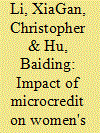| Srl | Item |
| 1 |
ID:
107483


|
|
|
|
|
| Publication |
2011.
|
| Summary/Abstract |
The impact of microcredit on women's empowerment remains controversial, as documented in the microfinance literature. While some studies claim that microcredit helps women increase their income earning abilities, leading to greater power to overcome cultural asymmetries, others contend that small loans allocated to women are usually controlled by their spouses, which results in more severe subordination of women and leaves them more vulnerable to the patriarchy system within the household and/or at society level. This paper evaluates the empowerment impact of microcredit on rural women in China. Logistic regression is employed for empirical analysis and data are collected through a rural household survey. The results confirm that microcredit has a significant impact on five dimensions of women's empowerment, ranging from economic security to awareness of social/legal issues.
|
|
|
|
|
|
|
|
|
|
|
|
|
|
|
|
| 2 |
ID:
136259


|
|
|
|
|
| Summary/Abstract |
Most studies on measuring China's energy efficiency were conducted in the framework of the input-oriented Data Envelopment Analysis. This approach generally calculates the technical efficiency by shrinking all the input factors equally proportionally subject to the observed output still being producible. Thus, all the input factor efficiencies, including the energy efficiency, are measured as the technical efficiency. One drawback of this approach is the presumption of an identical input factor frontier for all input factors and of unrestricted factor substitutability. The present study employs a stochastic frontier analysis approach to measuring energy efficiency that not only allows for non-identical input factor frontiers, but also controls for the effects on the measure of energy efficiency of substitution away from energy or substitution of energy for non-energy factors. This approach is applied to evaluating the efficiency performances of three types of energy amongst a sample of coal mines, petroleum refineries and power plants in China's energy sector which is specifically targeted by the Chinese government to improve energy efficiency.
|
|
|
|
|
|
|
|
|
|
|
|
|
|
|
|